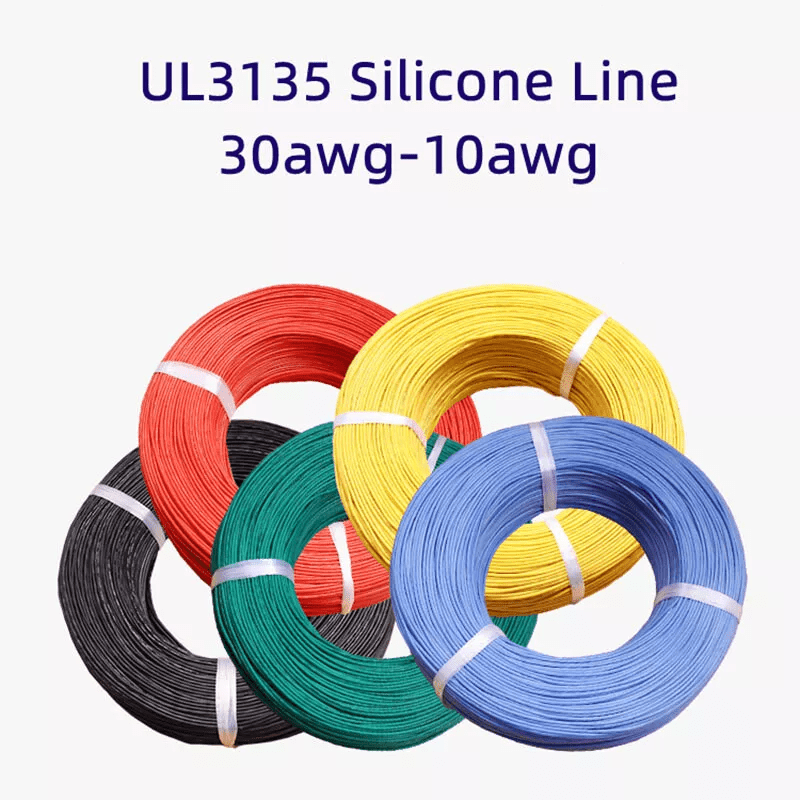1. Product core introduction
10AWG - 30AWG Silicone Wire, a flexible stranded cable with tinned copper conductors and a unique green and grey exterior design. Focused on providing a premium solution for your electrical connection needs, this product is on par with UL3135 silicone wire in terms of quality and reliability, ensuring stable power and signal transmission, whether it's for DIY electronics projects, automotive electrical systems or industrial applications.
2. The main characteristics of the product
A wide range of AWG sizes, from 10AWG to 30AWG, can accurately match the different current-carrying requirements of all kinds of electrical equipment. In high-power industrial equipment or automotive starter motors, the 10AWG - 16AWG thick wire diameter can ensure smooth transmission of large currents and avoid the risk of overheating caused by too small a wire diameter; for small electronic equipment, sensors, or precision instruments, the 24AWG - 30AWG thin wire diameter not only meets the fine demand for power, but also facilitates the flexible wiring in a limited space to optimize the layout of the electrical system and enhance overall performance and safety. It also facilitates flexible wiring in limited space, optimises the layout of the electrical system, improves overall performance and safety, and ensures that each device receives the right amount of power supply.
High-quality silicone insulation: The choice of high-quality silicone as the insulation layer gives the cable excellent flexibility, making it easy to achieve multi-angle bending and twisting, perfectly adapted to a variety of complex installation environments, whether it is narrow inside the electronic equipment, or compact space in the engine compartment of the car, can be freely shuttled, greatly reducing the difficulty of installation and improving work efficiency. At the same time, the silicone insulation layer has excellent heat resistance, can maintain stable physical and electrical properties at high temperatures, effectively preventing the insulation layer from aging, deformation or damage, to ensure the reliability of the cable in the long-term use of the process, significantly extend the service life, reduce the cost and trouble brought about by frequent replacement of the cable.
Tinned copper conductor has significant advantages: the conductor is made of tinned copper, which has good electrical conductivity, can effectively reduce the resistance, reduce the energy loss in the process of power transmission, and ensure the efficient and stable transmission of power to various devices, enhance the operational efficiency of the electrical system. Moreover, the tinned layer provides strong antioxidant and corrosion protection for the copper wire, enabling it to maintain good conductivity in humid, high-temperature or chemically corrosive environments, avoiding line failures due to oxidation or corrosion of the conductor, and laying a solid foundation for the long-term stability of the electrical connection.
Dual-colour design for easy differentiation: the green and grey exterior design provides a clear and convenient line marking solution for electrical wiring. In complex electrical systems, users can use green and grey cables for different functional lines according to their own habits or common electrical standards, such as green for signal transmission lines, grey for power lines, etc., so that the wiring is more neat, standardised and easy to identify and manage. This is in the process of equipment installation and commissioning, troubleshooting and maintenance, can quickly and accurately locate the target line, saving time and energy, greatly improving work efficiency and accuracy, effectively reducing operational errors and safety hazards caused by line confusion.
3. Product use scene
Automotive electrical system upgrading and modification: automotive audio system optimisation, automotive lighting modification (such as headlight upgrading, fog lamp retrofitting, daytime running light modification, etc.), electric seat installation, automotive electronic equipment retrofitting (such as car recorder, car navigation, reversing radar, etc.) and other automotive electrical modification projects, which require extremely high performance of the cable. The cable's high temperature resistance, flexibility and various AWG specifications enable it to easily cope with the complex environment in the car engine compartment and cabin, and meet the power requirements of different automotive electrical equipment. For example, in car audio modification, suitable AWG specifications can be selected according to the power size of the amplifier, which can be connected to the power supply and speakers of the car through the soft silicone cable to ensure clear and stable sound quality; in car lighting modification, its good insulation and temperature resistance can ensure the normal operation of the lighting system, improve the lighting effect and safety of the car, and meet the owner's pursuit of personalisation and functionality of the car. Pursuit.
Industrial automation and equipment manufacturing: In industrial automation production lines (such as robot arm control, automated machine tool electrical connection, sensor data transmission, etc.), industrial equipment manufacturing (such as motor drives, electrical control cabinets, industrial heating equipment, etc.), as well as in the field of industrial equipment maintenance, the cable is able to withstand the high temperature, high humidity, strong vibration, electromagnetic interference, and other harsh conditions in the industrial environment. Different AWG specifications of the cable can be used to transmit power supply, control signals and data signals, to meet the strict requirements of industrial equipment for high precision, high reliability and high stability of the electrical connection. The tinned copper conductor's good electrical conductivity and oxidation resistance, as well as the silicone insulation's heat and aging resistance, ensure the cable's long-term stable operation in industrial environments, reduce equipment failures and downtime, improve production efficiency, and provide a strong safeguard for the production and operation of industrial enterprises.
Small commercial and household electrical equipment connection: The reliability and safety of this cable makes it an ideal choice for lighting systems and electrical equipment connection in small commercial premises (e.g. shops, restaurants, offices, etc.), as well as for wiring and installation of all kinds of electrical appliances (e.g. air conditioners, refrigerators, washing machines, electric water heaters, etc.), lighting fixtures, and smart home devices in households. Its various AWG specifications can meet the needs of different power devices, the soft silicone material is convenient for wiring in limited space, the two-colour design is easy for users to differentiate the lines and ensure the specification and safety of the electrical connection, which provides stable power support for commercial operations and family life, ensures the normal use of all kinds of electrical equipment, and improves the convenience and safety of life and work.
4. Product use instructions
Preparation before installation:
Comprehensively and meticulously check the appearance of the cable, focusing on whether there are any quality problems such as breakage, scratches, flaking insulation, loose strands, oxidation and discolouration of copper wires. If any abnormality is found, stop using it immediately and contact the supplier for replacement in time to ensure that the cables put into use are intact in terms of physical structure and electrical performance.
Wiring and connection:
When planning the wiring path, give full consideration to the actual installation environment of the space layout, temperature conditions, electromagnetic interference sources and other factors, rationally design the cable direction to avoid excessive bending, twisting or stretching of the cable. If it is not possible to avoid potential hazardous factors, the cable should be isolated, protected and fixed in advance by choosing suitable wire troughs, bushings, protective sheaths or insulating materials to ensure that the cable operates in a safe and stable environment.
When the cable and equipment connection operation, the first use of wire stripping pliers carefully and cautiously stripped off the cable end of the insulation layer, accurately exposed to meet the requirements of the connecting terminal length of stranded copper wire (generally 3-5 mm or so, the specific length of the connecting terminal according to the type and specifications), and then insert the copper wire into the connecting terminal, and the use of crimping pliers uniformly, firmly pressed to ensure that the connection is close and reliable, good contact To avoid loose, false connection and other bad connections, and to prevent electrical faults (e.g. heat, fire, signal attenuation, etc.) caused by excessive contact resistance. If welding connection is involved, appropriate solder wire and professional welding skills should be used to ensure that the welded joints are rounded, smooth, firm and free of false soldering, and after the welding is completed, the welded joints should be insulated in a timely manner (such as applying insulating varnish, wrapping insulating tape, or sleeving heat-shrinkable tubing), to prevent short-circuiting of the welded joints and leakage of electricity, and to ensure the safety and stability of the electrical connection.
Precautions for use:
Always use this cable in strict compliance with the rated voltage and current parameters specified clearly in the product specification, and it is strictly prohibited to exceed their permissible maximum values under any circumstances. Otherwise, it may cause serious electrical safety accidents, such as overheating of the cable and fire, short-circuiting and burning of equipment, or even endanger personal safety. When connecting multiple electrical devices to form a system, be sure to accurately calculate the total power and total current of the system, combined with the current-carrying capacity of the cable, and reasonably distribute the load, to ensure that the selected cable can safely and stably carry the operating current of the entire system, and to avoid all kinds of potential risks and problems caused by overloading.
Try to avoid prolonged exposure of the cable to harsh environmental conditions such as high temperatures, open flames, humidity and corrosive chemicals. Although the cable has a certain degree of high temperature and corrosion resistance, but long-term exposure to extreme harsh environments will still have an adverse effect on its performance, accelerate the aging of the insulation layer, reduce the conductor conductivity, thereby affecting the service life of the cable and electrical safety performance. If you can not avoid the above unfavourable environmental factors in actual use, you should take effective protective measures in a timely manner, such as the use of fire, water, corrosion-resistant wire troughs, casing, shielding, etc. for a full range of cable protection, to ensure that the cable in the harsh environment is still able to maintain a stable and reliable operating state, extend its service life, reduce maintenance costs and safety risks.
Regularly carry out a comprehensive inspection of the connection parts and overall appearance of the cable, especially after the equipment has experienced a long period of operation, frequent starts and stops, poor working conditions (such as high temperature, high humidity, strong vibration) or suffered from accidental impact of external forces, it is more important to strengthen the inspection efforts and frequency. Carefully check whether there is a loose connection, oxidation corrosion, insulation layer damage, stranded wire scattered and other abnormalities, such as any problem found, should immediately stop for repair or replacement of damaged parts, to ensure that the cable is always in a normal, safe working condition, to protect the stable operation of the entire electrical system and personnel and equipment safety. At the same time, in the process of equipment maintenance, overhaul or other operations involving the electrical system, be sure to pay attention to the protection of cables, to avoid unnecessary damage to the cable due to human negligence, misoperation or improper external forces, affecting its normal use of performance and life.



















